Year 9 (Grade 8) Interdisciplinary Signature Work Inquiry @ Blanchelande College
Home › Forums › Inquiry and resource design › Year 9 (Grade 8) Interdisciplinary Signature Work Inquiry @ Blanchelande College
- This topic has 18 replies, 1 voice, and was last updated 6 months, 2 weeks ago by
 Darryl Toerien.
Darryl Toerien.
-
AuthorPosts
-
22nd October 2022 at 10:50 am #79223
We have just launched our Year 9 interdisciplinary Signature Work inquiry, which, initially, is a collaboration between ICT/ Computer Science and English.
I will reflect on this further over the coming week, which is our half term break, but highlight here that this will allow us to develop work started at Oakham School, particularly the Year 9 FOSIL Inquiry Skills Project and Year 9 Individual Project.
13th November 2022 at 11:17 am #79309Sorry – this was more complex to set up properly than I’d anticipated, mainly because it is an expanded opportunity to think though this instructionally from the perspective of Year 9 and from the perspective of the systematic and progressive development of Signature Work inquiry skills development across primary and secondary – see below for priority skills in transition years (or download as high resolution PNG), and also the Forum topics, Year 6 (Grade 5) Interdisciplinary Signature Work Inquiry @ Blanchelande College and FOSIL and the Extended Project Qualification (EPQ) from this post onward.*
I also include below (or download as a high resolution PNG) an overview of the digital inquiry skills course component of the Signature Work Inquiry.

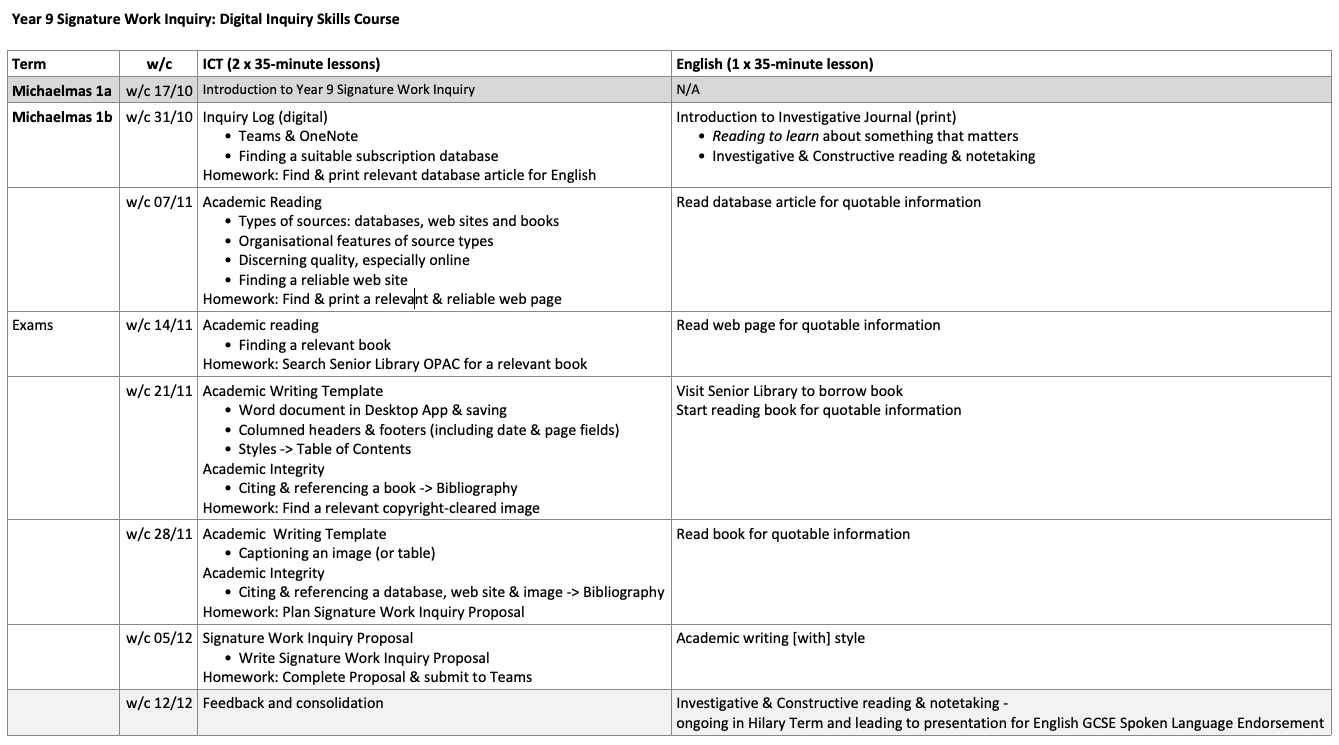
*As an aside, some of the inquiry skills that Jenny needed to teach from scratch in the 6-week Year 12 (Grade 11) inquiry skills course I am now teaching from scratch in the Year 9 digital inquiry skills course, and some of those we will teach from scratch in the Year 6 Signature Work Inquiry – it will take a couple of years for this to bear fruit, but what fruit it will be.
19th November 2022 at 9:23 am #79313We will spend the next two lessons setting up the Signature Work Inquiry Proposal (see below, or download as PNG) ahead of students writing their proposals in the final lesson. For various reasons, it is unlikely that we will be able to include captioning and citing a relevant image, at least at this point. This is the first iteration of the Year 9 Signature Work Inquiry, so very much still a work-in-progress.
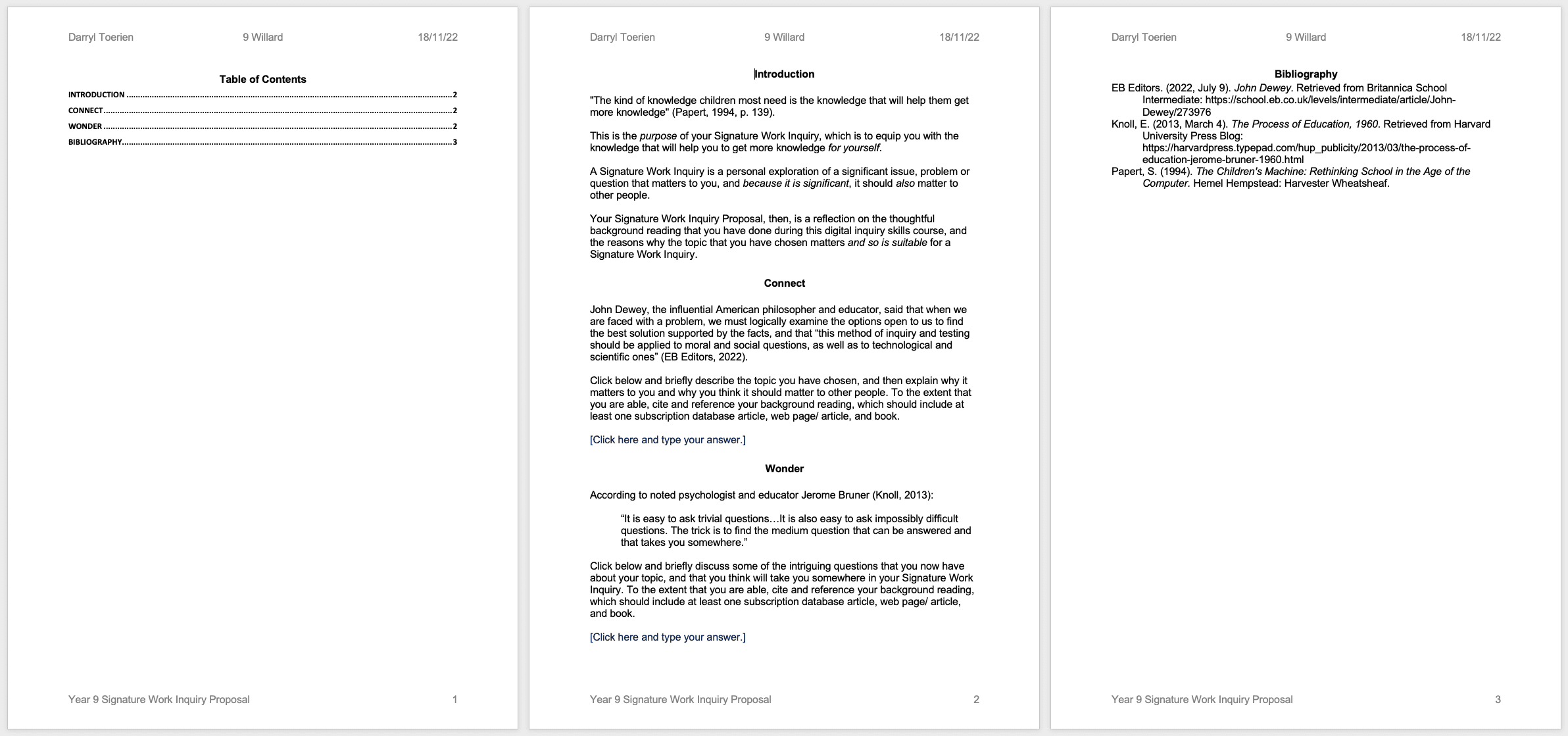 3rd December 2022 at 3:29 pm #79317
3rd December 2022 at 3:29 pm #79317I have simplified the Signature Work Inquiry Proposal (see below, or download as PNG) in order to help students focus more clearly on what they need to accomplish in writing their Proposal.
The quotations that I used serve to help explain the purpose of the Signature Work Inquiry and the Proposal, while also providing examples of how to work with other people’s ideas (academic integrity) and giving students the opportunity to cite and reference a book, subscription database article (treated as a web site in Word) and a web site article. I can do this better but that will have to wait until next year.
This week, students will write their Proposals, and will reference their own sources, which should include at least one relevant and reliable book, subscription database article and web site article.
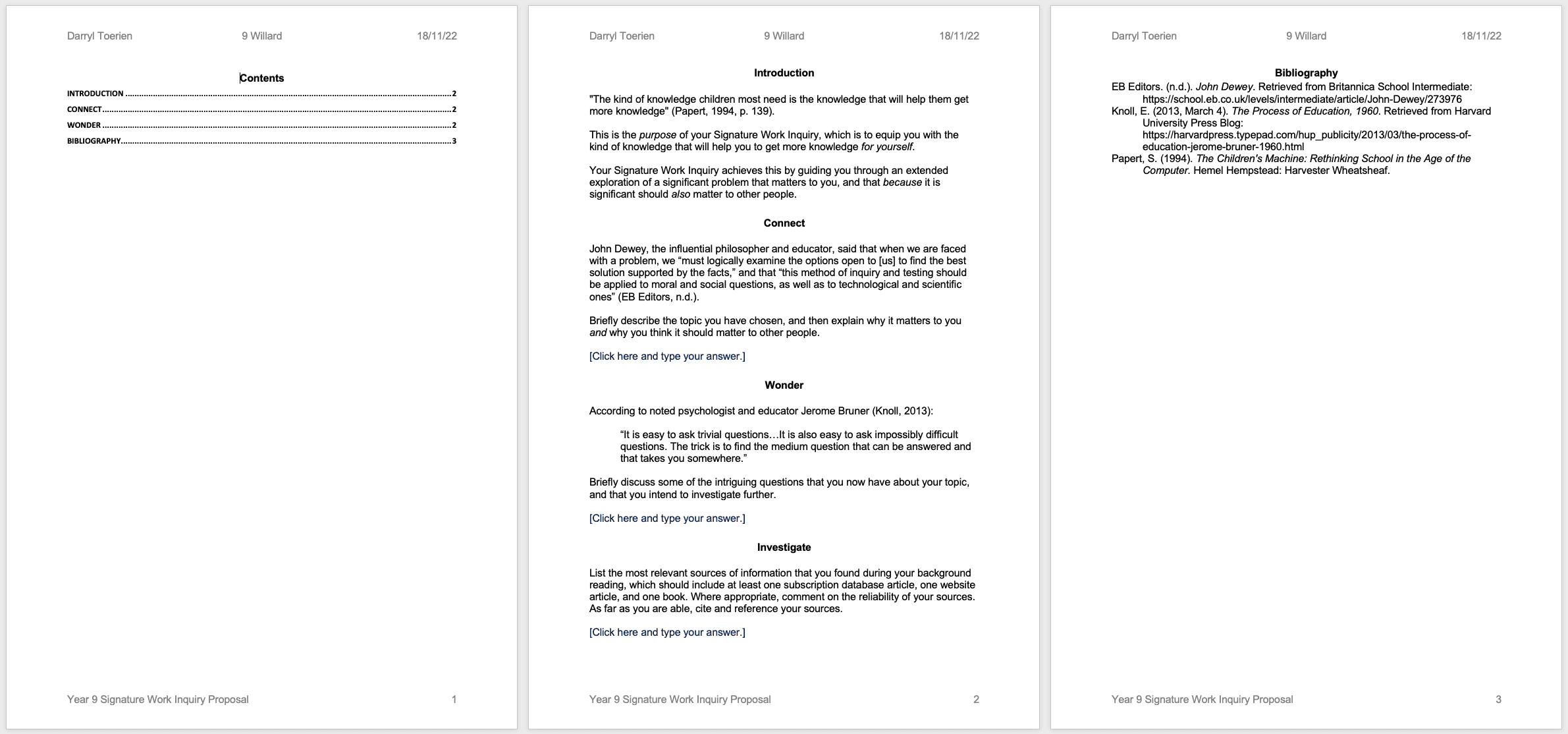 9th December 2022 at 6:55 pm #79372
9th December 2022 at 6:55 pm #79372I have made a final revision to the Signature Work Inquiry Proposal template (see below, or download as PNG) to further clarify what students need to focus on, and to better reveal the logic of the Signature Work Inquiry Proposal. I will reflect on this development in due course, and upload the checklist that I developed to ‘mark’ the Proposals.
{Edit: This worked much better with the final class today.}
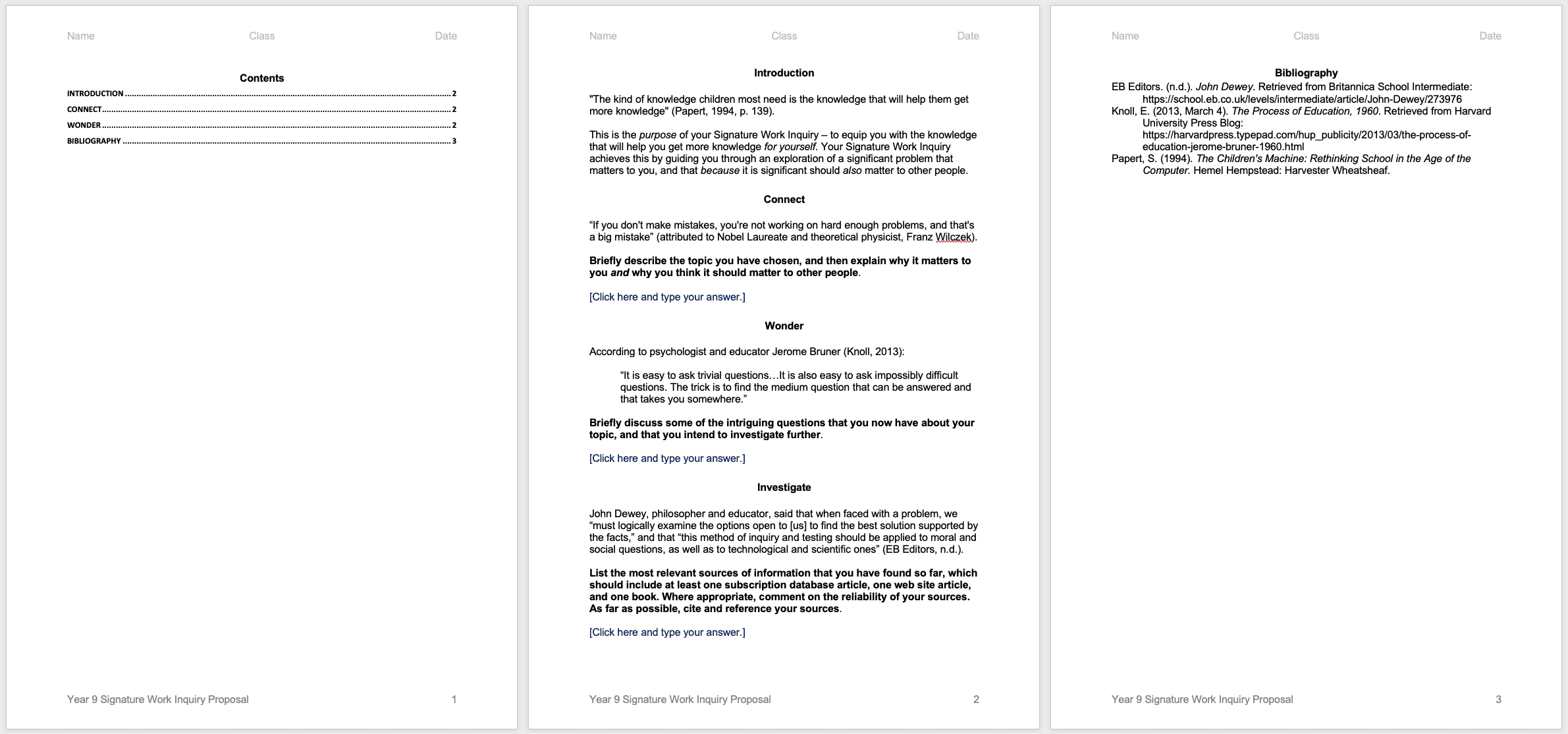 1st March 2023 at 2:05 pm #79735
1st March 2023 at 2:05 pm #79735Having submitted their Signature Work Inquiry Proposals, students have been investigating their topics in their weekly timetabled English reading lesson, which links to the key whole-school academic target of learning from reading. Purposeful use of the Investigative Journal ensures that the reading is relevant and thoughtful. It also underscores that thoughtful reading takes time, and that students actually are given very little time to learn to do so effectively. Next year we will more purposefully explore a range of notetaking approaches (see relevant Investigate skill set below).
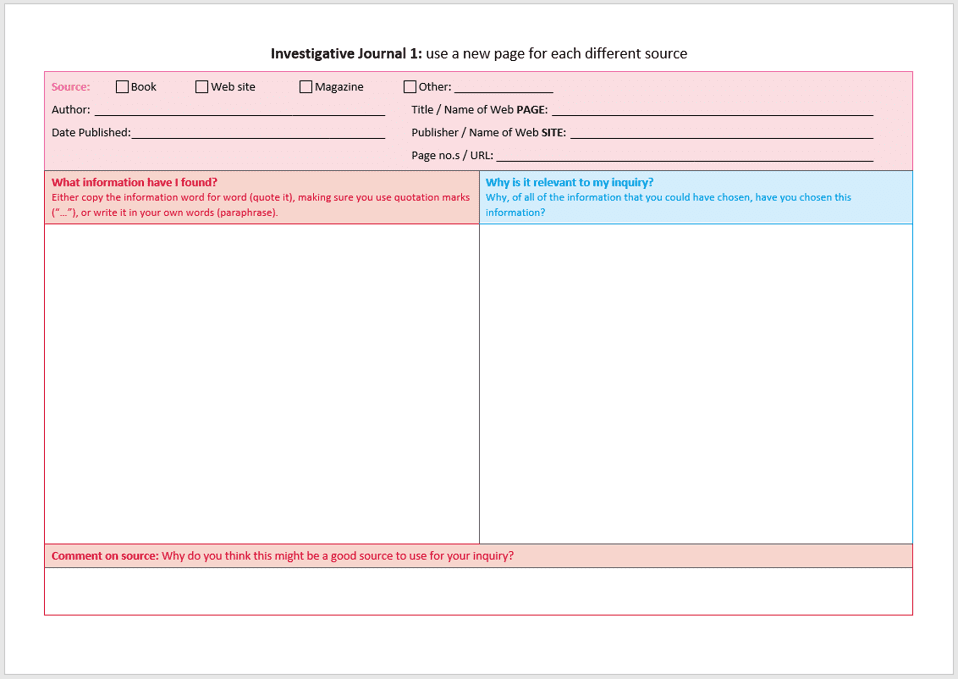
One of the outcomes of the Year 9 Signature Work Inquiry will be the compulsory GCSE English Language endorsement for Spoken Language, which in our case is administered by AQA.
For the endorsement, students must deliver a prepared spoken presentation on a specific topic, for which the key requirements are:
- A prepared spoken presentation of up to 5 minutes plus up to 5 minutes Q&A
- Must be on an agreed topic
- Must be formal
- Must be planned and organised (i.e., prepared)
- May use cue cards, PowerPoint, etc.
- Must listen to and respond appropriately to feedback
The assessment criteria for the endorsement are:
- General Criteria
- Audible
- Intelligible using appropriately formal language
- Specific Criteria for Distinction
- Express sophisticated ideas/ information/ feelings using a sophisticated repertoire of vocabulary
- Organise and structure presentation using an effective range of strategies to engage audience
- Achieve purpose of presentation
- Listen to questions/ feedback and respond perceptively, and if appropriate elaborate with further ideas and information
With this in mind, students were recently given an opportunity to prepare and deliver an elevator pitch – a short presentation of up to 1 minute – that is designed to generate interest in and support for an idea. For their elevator pitch, students needed to:
- Introduce themselves
- Introduce their topic, which required them to decide how much to explain about their topic for it to make sense to the audience
- Explain why their topic mattered to them
- Explain why their topic might matter to other people
In addition to giving students an early opportunity to talk briefly about their topic, which was surprisingly daunting for some, the elevator pitch also highlighted the importance and value of their investigative reading. Towards the end of this half-term, we will shift from the Investigate skills sets to the Construct skill sets, with a view to shifting to the Express skill sets early next term (which will more directly involve the English teacher as we begin to prepare for the assessed formal presentation).
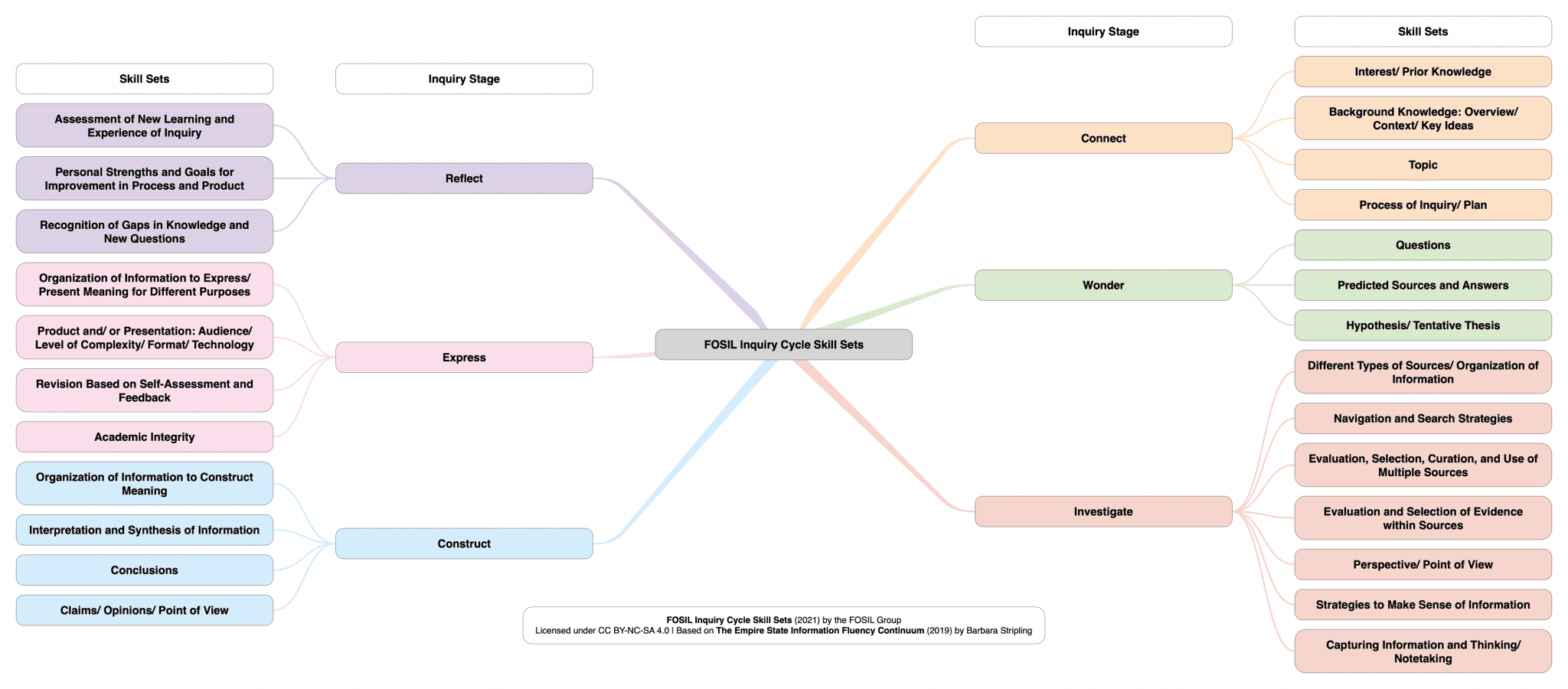
I will reflect on this further in relation to relevant and appropriate priority skills in due course.
25th May 2023 at 9:39 am #80555There is much that I need to update on, which I will do in due course. Of particular interest now, though, is the opportunity to look ahead to the next academic year, which starts in September 2023.
I have been re-working my way through Action, Talk, and Text: Learning and Teaching Through Inquiry (Wells, 2001)* ahead of a whole-staff INSET on Tuesday 30 May on lessons that we have learned from the Year 6 (Grade 5), Year 9 (Grade 8) and Year 12 (Grade 11) Signature Work inquiries that have broader application (which we will share when done).
What I had not fully appreciated before, was the significance of action, talk and text to learning and teaching through inquiry, or the relationship between them. The request, then, at this time to add a Year 9 (Grade 8) Signature Work strand to the 2023-4 English Key Stage 3 (Years 7-9/ Grades 6-8) Overview – see Effecting Change Through Policy for some background – has uncovered some of this significance for me. While this work is still unfolding, and will require further reflection, I share the Year 9 (Grade 8) Signature Work strand below, which is essentially complete. Given the vital role of reading and writing in learning, and especially in an inquiry-based approach to learning, I have emphasized this in the overview and will return to it later.
Please note that I have only added the top row – Signature Work and FOSIL Stages – to the Overview. I have added the second row – FOSIL Deep Reading [and writing] Skills – here because I am still thinking through this with reference to Reading for Inquiry Learning in the Forum, and specifically Barbara‘s reflections on deep reading from this post onwards. Click on image below to enlarge or download as PNG.
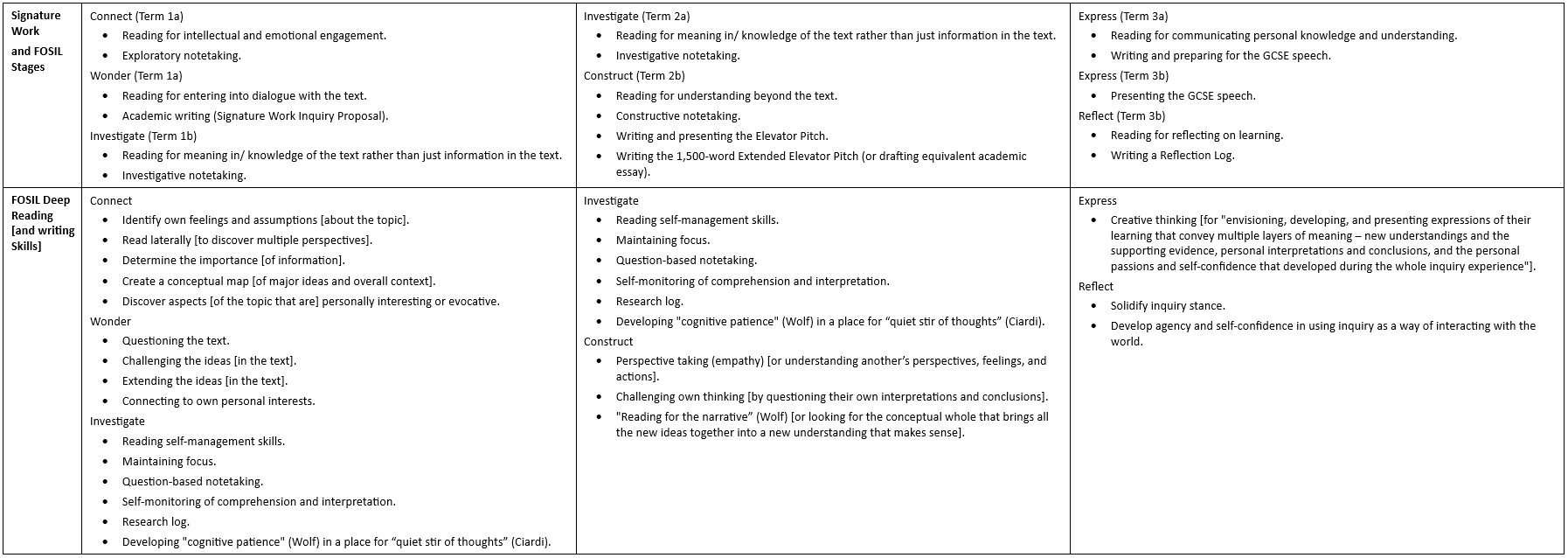
I will update further as soon as time permits.
*This book reflects on 10 years of action research carried out by DICEP (the Developing Inquiry Communities in Education Project), which was initiated by the Ontario Institute for Studies in Education (OISE) of the University of Toronto. This collaboration between teacher educators from OISE and teachers in metro Toronto and surrounding areas – initially on “a study of ‘Learning through Talk’ in elementary science classrooms” – grew in focus “to include opportunities for inquiry-based learning and teaching at all levels and in all areas of the curriculum” (p.2).
21st June 2023 at 4:25 pm #80740We have finally made it to our inaugural Year 9 (Grade 8) Signature Work Celebration, which takes place this evening.
I still have much to reflect on here, but thought I would share my brief introduction to the event and the poster template.
In writing the introduction I have had in mind Neil Postman’s assertion that “non-trivial schooling can provide a point of view from which what is can be seen clearly, what was as a living present, and what will be as filled with possibility” (1996, p. x).
—
Seymour Papert, the visionary founder of the Future of Learning Group at the MIT Media Lab, said that we cannot teach students everything that they need to know, so the best we can do is position them where they can find what they need to know when they need to know it. This is truer today than it was when he first said it, and it is not a simple task – in fact, doing this properly will take our collaborative efforts over all of your child’s time in school.
Signature Work – an interdisciplinary inquiry-based exploration of a significant topic of deep personal interest – is vital to this task, and is now in place for:
- Year 1
- Year 6, combining work in Art and Design, English, ICT, Library, Maths and Science, and leading to the CREST Bronze Award
- Year 9, combining work in ICT, English and Library, and leading to the GCSE English Language NEA and optional HPQ in Year 10
- Year 12, combining work in Library and Theology/ Thought and Culture, and leading to an optional EPQ in Years 12 & 13.
Signature Work is central to our efforts to ensure that students leave Blanchelande as independent thinkers and learners, ready to strengthen, as Jonathan Rauch puts it, the reality-based community of error-seeking inquirers upon which democracy depends.
The Year 9 Signature Work combines work in ICT on digital inquiry with work in English towards the GCSE English Language speaking and listening Non-Examined Assessment, which is centred on a formally presented speech followed by a Q&A session with the audience. Each class voted for a student to represent them tonight, and you will hear these speeches in a short while.
The Signature Work posters that are on display truly reflect a Heroic journey, for all students overcame very real dragons along the way. Superficially, the posters look nearly identical, which is deliberate – academic writing makes certain demands on the author, and the posters reflect the formal nature of the English speeches. This superficial similarity couldn’t be further from the truth, though. Upon closer inspection, each poster is as unique as the signature it bears, which brings me to what we are celebrating tonight – not the Signature Work, but the students whose Heroic Inquiry led to it.
To give you a fuller taste of this, Miss Flood and I take great pleasure in introducing the students who were chosen by their classmates to represent them.
- Maddie: The dilemma of euthanasia.
- Yagmur: The problem of gun control in America.
- Emily: Did anything good come out of the Great Fire of London?
—
 31st October 2023 at 3:44 pm #81701
31st October 2023 at 3:44 pm #81701I had hoped to reflect here on changes to this year’s inquiry before the start of our academic year in September, but time did not permit.
A major change was that the inquiry started in September – which is the start of our academic year, rather than mid-October – in both Computing and English, which meant that for the first half-term each class had three 35-minute lessons, two in Computing and one in English. This presented an opportunity, but also a challenge. The opportunity lay in more purposefully integrating the digital inquiry component in Computing with the informational reading component in English from the outset of the inquiry. This was also the challenge.
Last year, students were able to choose any topic that interested them, provided that their topic presented them with a problem or question that they would explore and discuss as part of their Signature Work inquiry. This degree of openness was appropriate for the culminating product, which was their GCSE English Language speaking and listening Non-Examined Assessment (NEA) on a topic of their choice (see posts above). This created two practical problems. Firstly, a number of students struggled to arrive at a problem or question related to their topic, which made it difficult for them to fully satisfy the requirements of a Signature Work, or the NEA. Secondly, the wide variety of choice, while eventually a useful way to develop the collection, made it difficult to resource the inquiry with interesting and accessible texts, whether in print or online, in a timely way.
Given that a focus of the digital inquiry component is finding and working with online information, both in databases and on the web, one of our databases remained the most logical place to start. However, all students would need to start with the same article if they were to learn how to access the article virtually [by finding it in the database] and then physically [by printing it] in order to begin accessing it intellectually [by reading it] in their first English lesson.
Having attended a very interesting presentation on the United Nations Sustainable Development Goals (SDGs) at the IASL Annual Conference, the SDGs allowed me to solve both practical problems. Firstly, the Britannica School Intermediate article on the SDGs provided all students with the same starting point, although the SDGs are varied enough for all students to identify with one or more SDGs in a very personal way. Secondly, the SDGs by their very nature inescapably confront students with problems and/ or questions that they will increasingly give personal shape to.
At the same time, following our own presentation at IASL – Recovering the Educational Promise of Inquiry – I had been thinking long and hard about Neil Postman’s abiding commitment to “non-trivial schooling,” which “can provide a point of view from which what is [reality] can be seen clearly, what was as a living present, and what will be as filled with possibility” (1996, p. x). Inquiry, done properly, is non-trivial schooling, and in orienting students towards a problem or question framed within an SDG, the Signature Work inquiry had to do so in such a way that students could see what will be as filled with possibility, and would be empowered to begin fashioning reality from that possibility. Out of this, the theme of the Signature Work inquiry emerged:
The Future Needs You: Living Well in a World Worth Living in
I will reflect on lessons learned from this half term in due course, but end here with an overview the inquiry:
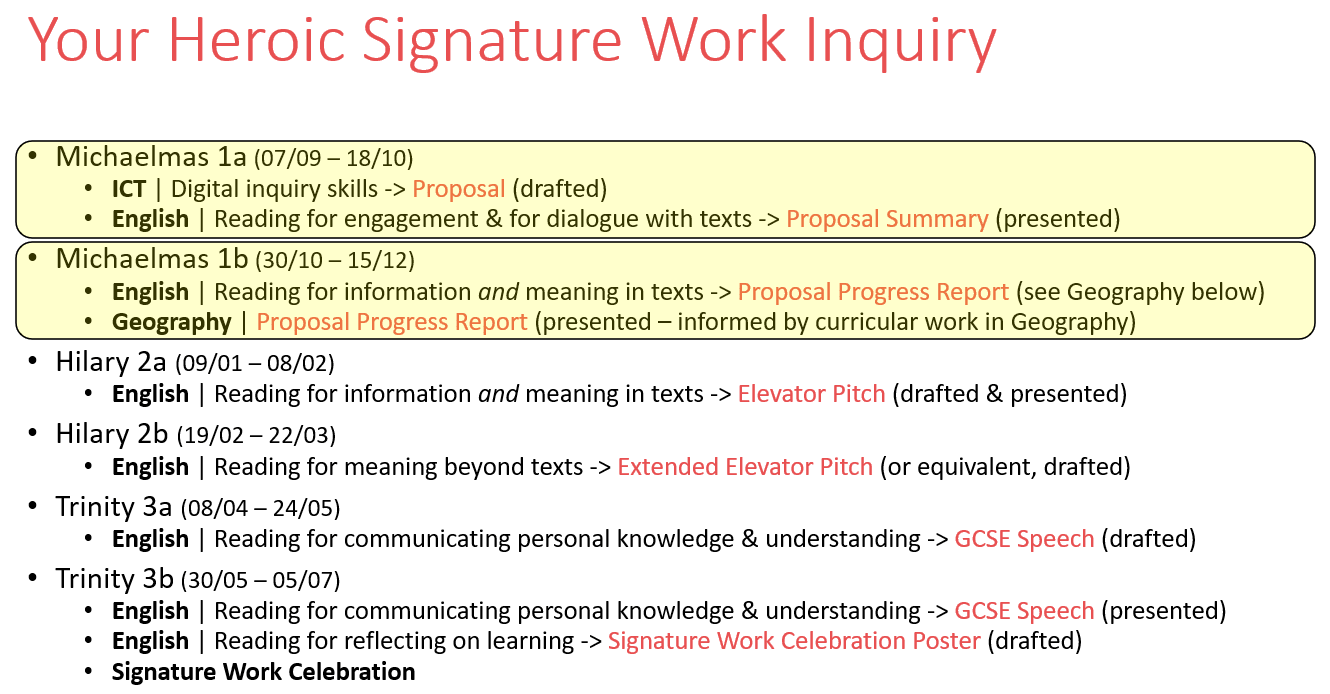 1st November 2023 at 4:25 pm #81718
1st November 2023 at 4:25 pm #81718I have revised the Investigative Journal that students will be using this half term as they now read for information and meaning.
The main change is the inclusion of an example (p. 2 below), which I might tweak slightly for greater clarity. I ended with the poster template from last year’s Signature Work Inquiry Celebration (p. 16), because I may tweak that slightly this year.
I will make this Investigative Journal available here once finalized next week.
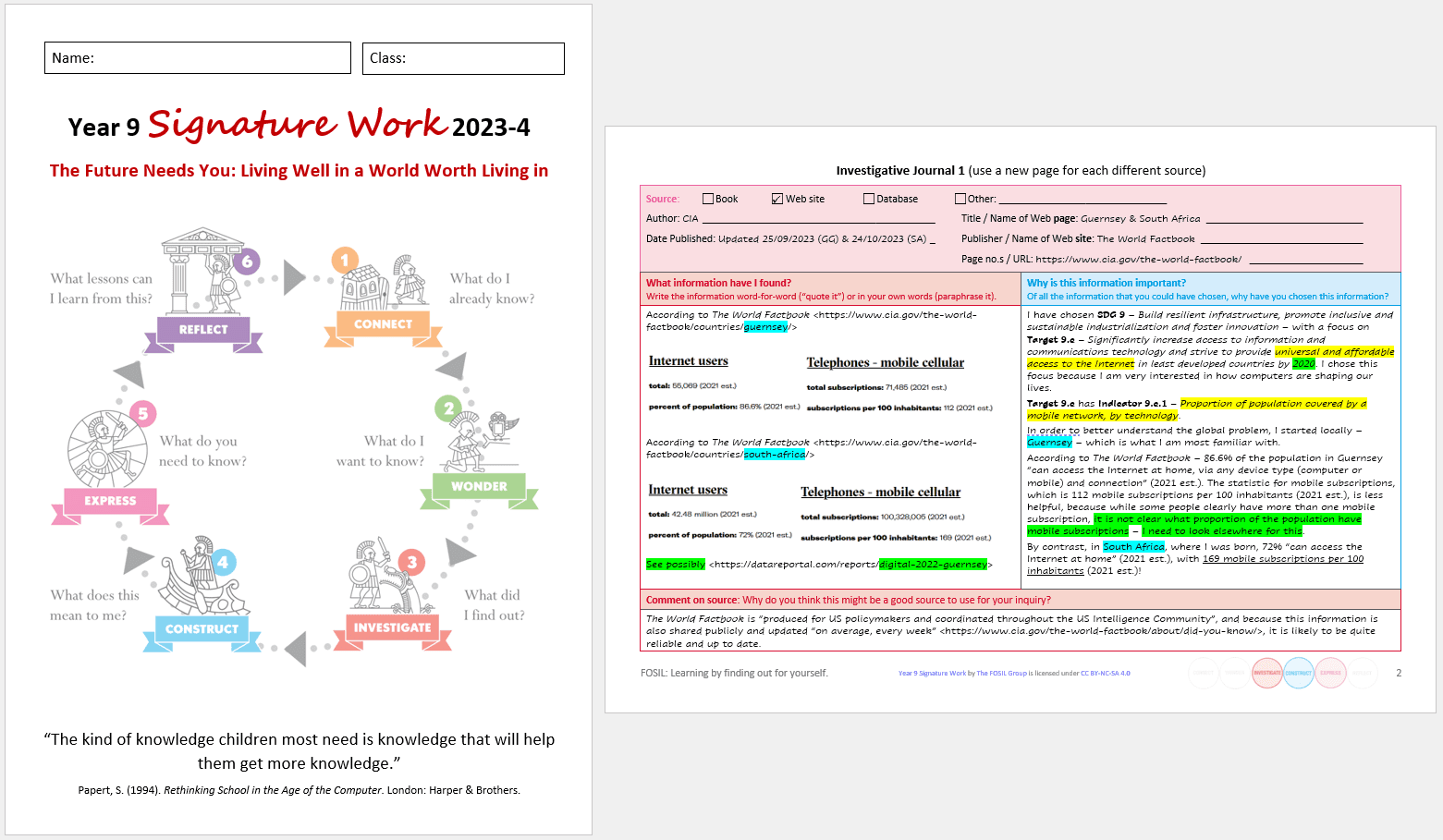
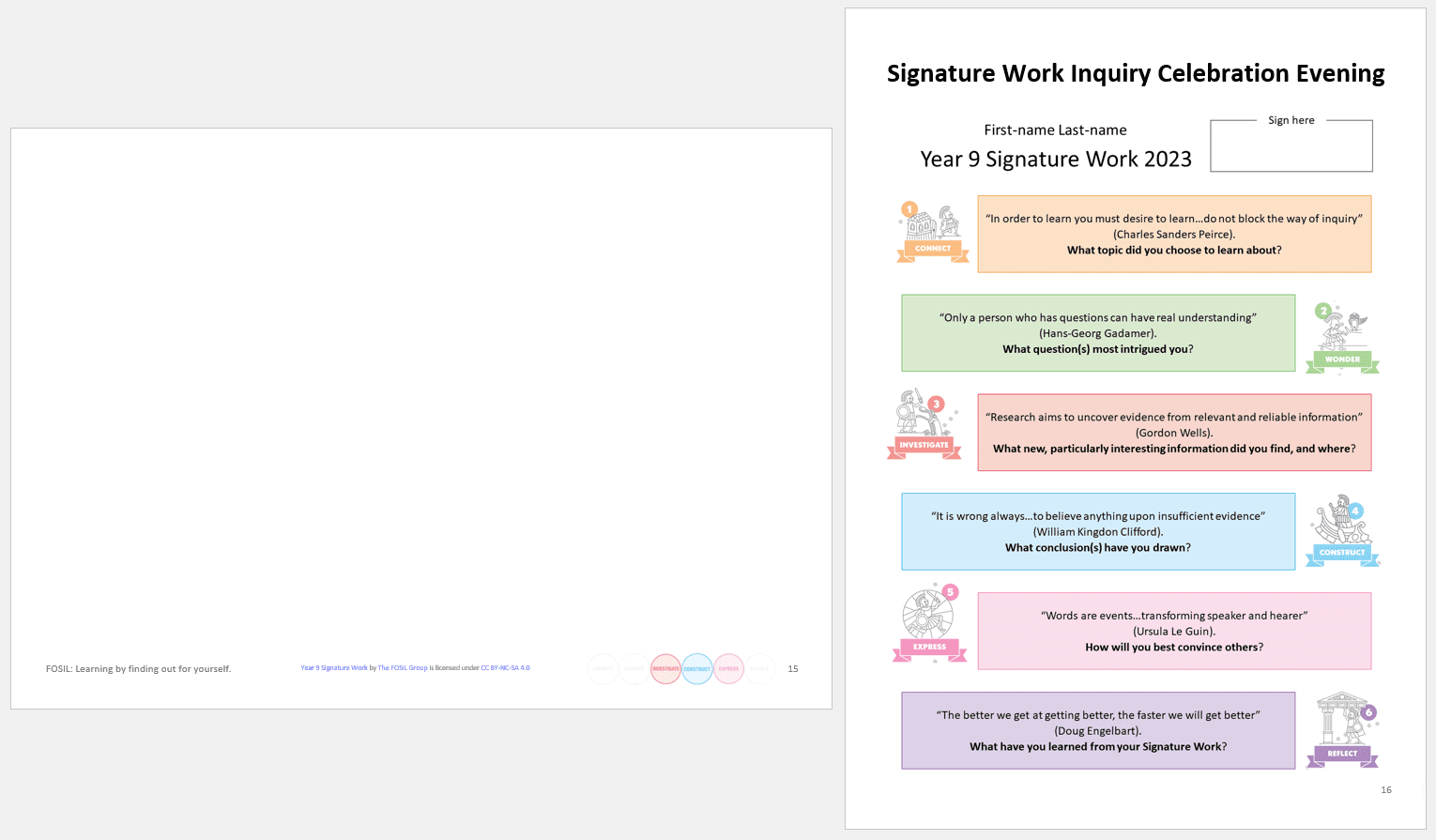 11th November 2023 at 11:08 am #81808
11th November 2023 at 11:08 am #81808I have only just realised that I have not explained what a Signature Work is, or where the idea comes from, which I will do at greater length when time permits.
In the meantime, this is essentially how we present it our students:
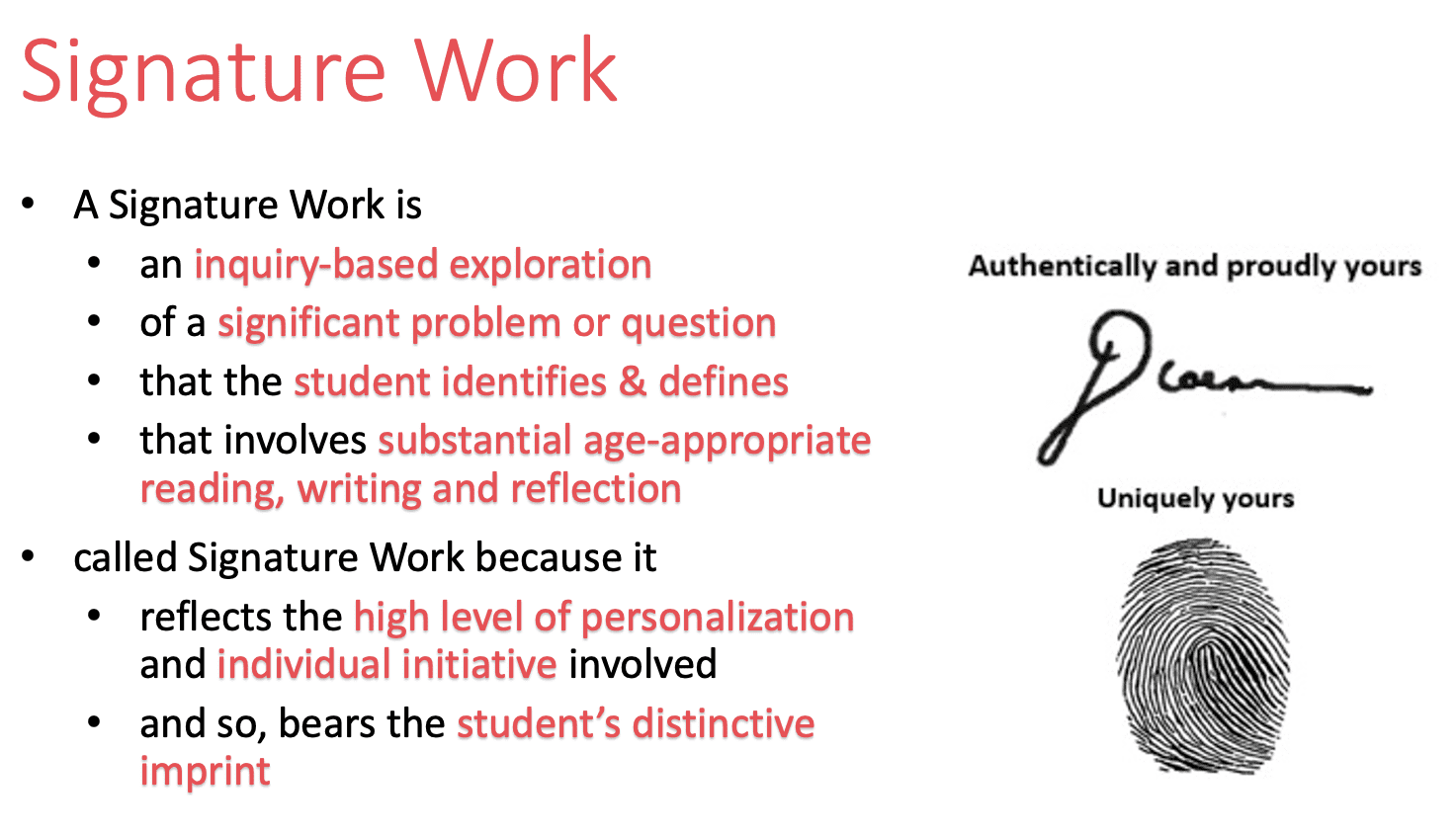 19th April 2024 at 10:12 am #83043
19th April 2024 at 10:12 am #83043For various reasons, some of which relate to timetabling, it was not possible to start working directly on the speeches at the start of this term (3a below). However, this did allow me to re-think the function of the 1,500-word written Extended Elevator Pitch at the end of last term (2b below), which was meant to lay the foundation for students to build their speeches on. Consequently, I moved the re-thought 1,500-word written piece from Term 2b to Term 3a, which I will explain further, although it still serves to lay a foundation, and a more solid one at that, for the students to build their speeches on, as well as prepare themselves for the subsequent Q&A session.

I have been reflecting on the following thoughts about the theme of learning through writing from The Development of a Community of Inquirers in Action, Talk & Text: Learning & Teaching Through Inquiry (Wells, 2001, emphasis added)*:
Linda: I conjectured that perhaps if writing is used as a tool for what I call ‘rehearsal thinking,’ would our oral discourse be one in which more will participate as well as [be] more substantive? … So I decided to use writing as a tool for individual thinking before embarking on a class discussion. … The consequences were amazing. First the pool of ideas surprised me. … It also provided the less confident…a chance to ‘see their own thinking’ & therefore feel more confident in being able to ‘read out their thoughts’ rather than having to respond not only spontaneously but also at the turn-taking speed of oral discourse. Another is that writing slowed down one’s thinking, making it more deliberate & intentional allowing one the ‘space’ to be more thoughtful, making one’s thinking visible for review & changes. Very significantly, writing provided everyone a ‘same-time’ turn & therefore increased dramatically the pool of knowledge which linear turn-taking in oral discourse does not. (pp. 12-13)
Gordon: [The resulting plan] indicated a focus on writing, not as a finished product, but as a tool to be used in some subordinate activity. It also indicated an expectation that action and talk would be intimately connected to the written text. (p. 13)
This led me to re-think the Extended Elevator Pitch, which was really a very loosely structured script for the speech, as an essay, but an essay as a tool for building knowledge and understanding rather than as an ‘assessment’ of knowledge and understanding. Because the English speech and Q&A is integral to the Signature Work, the fact that the Signature Work is an inquiry-based exploration of a significant issue, problem or question made a persuasive/ opinion or argumentative/ position essay most appropriate.
This aligns well with the FOSIL priority skills for Construct and Express:

It took me some time to think my way through the essay writing process, which resulted in the following essay flowchart and graphic organiser, which I have just given to the students:
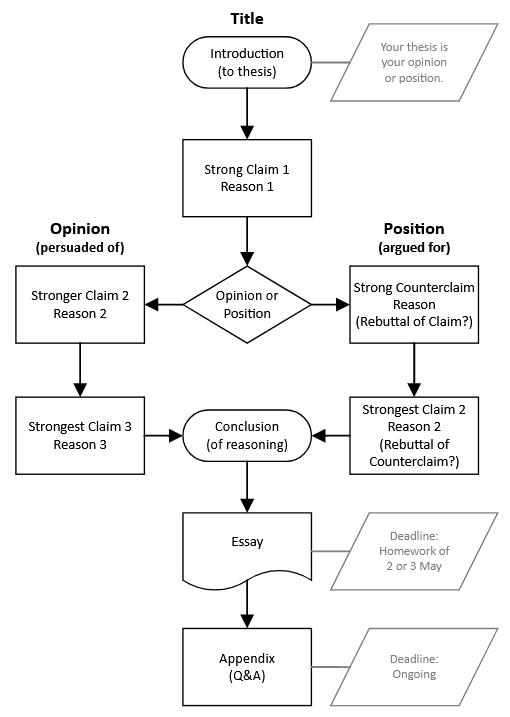
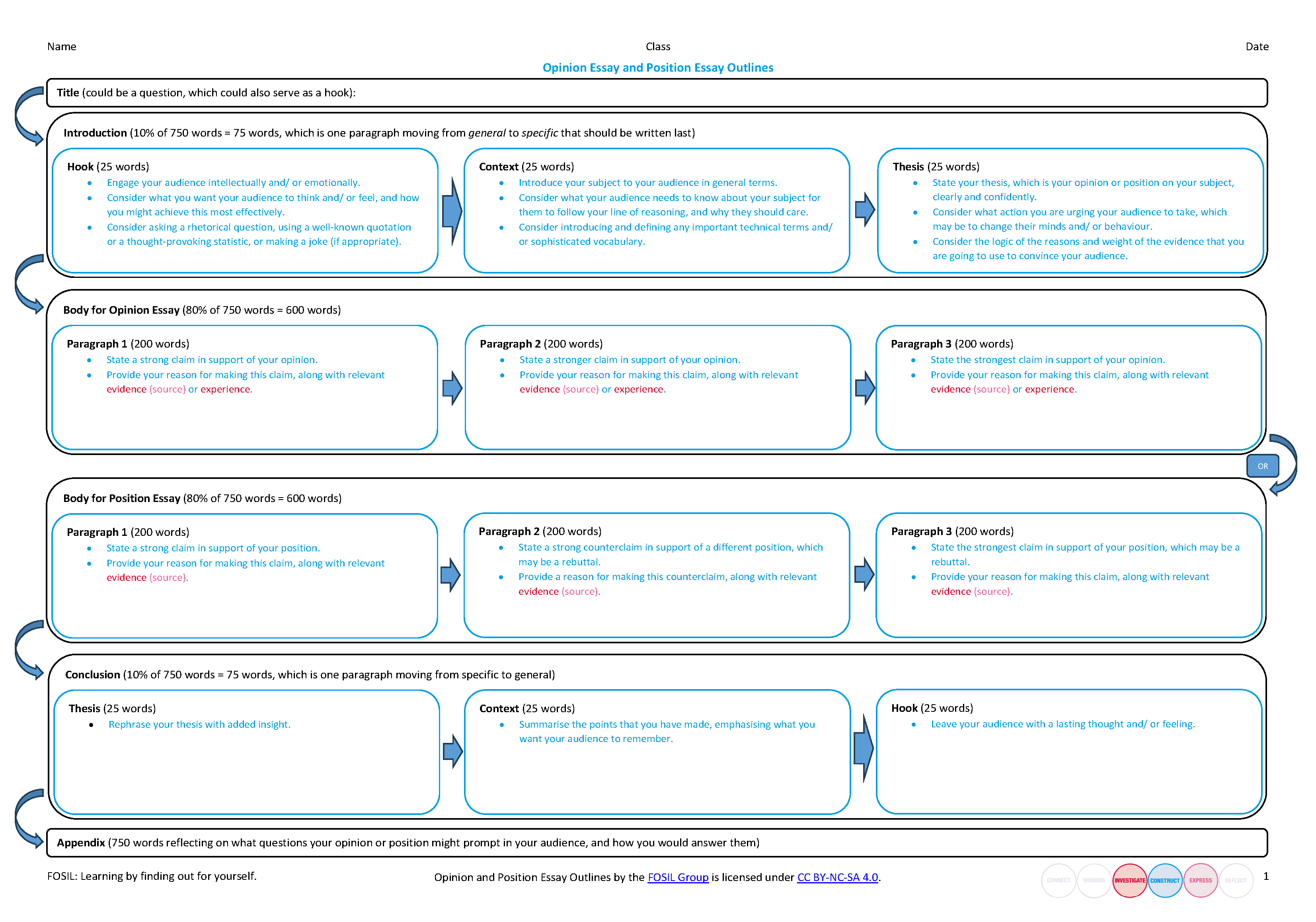
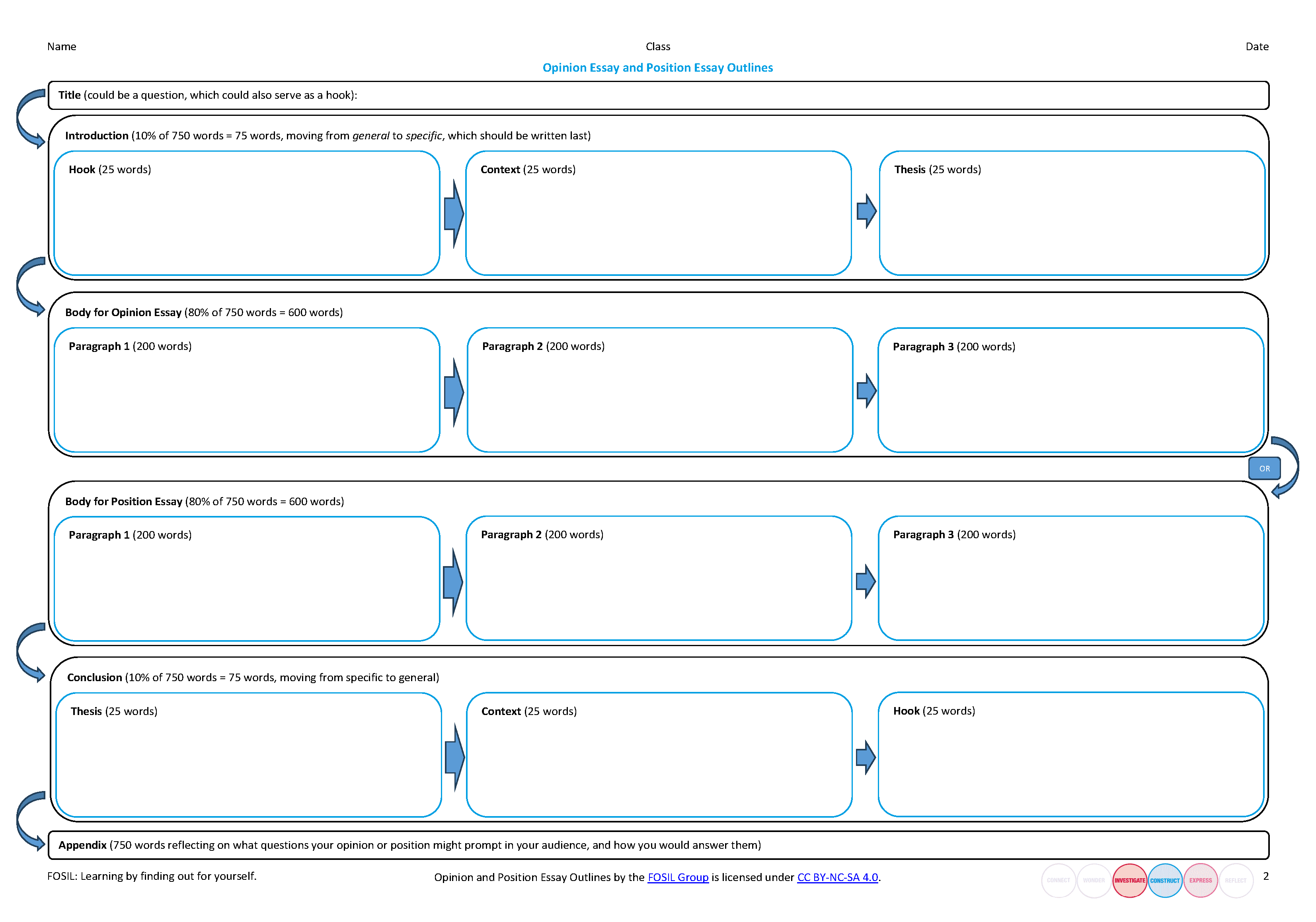 This development has raised some important questions, which I will reflect on in due course.
This development has raised some important questions, which I will reflect on in due course.*Wells, G. (2001). The Development of a Community of Inquiry. In G. Wells (Ed.), Action, Talk & Text: Learning and Teaching Through Inquiry (pp. 1-22). New York, NY: Teachers College Press.
1st May 2024 at 2:26 pm #83235To develop the idea of learning through writing further, Gordon Wells (2001)* continues:
The processes of thinking, such as categorizing, hypothesizing, reasoning, and evaluating, are not only realized in language, in the sense of being made manifest in speech and writing, but also actually constructed and improved through its mediating means. … The mediating role of dialogue in knowledge-building is probably most evident in face-to-face discussion. … Knowledge-building also takes place in the written mode … the writer engages in dual dialogue: with the audience to whom the text is addressed and with himself through dialogue with the emerging text. By the same token, reading another’s text also needs to be undertaken dialgogically. … Equally important, it is through the same sort of collaborative knowledge-building that each of us develops understanding of what other people have already come to know, as this is represented in texts and other knowledge objects. (pp. 184, 186-187)
Following on from the essay flowchart and essay plan graphic organiser above, I developed the essay draft graphic organiser and essay exemplar below (click on images to enlarge):
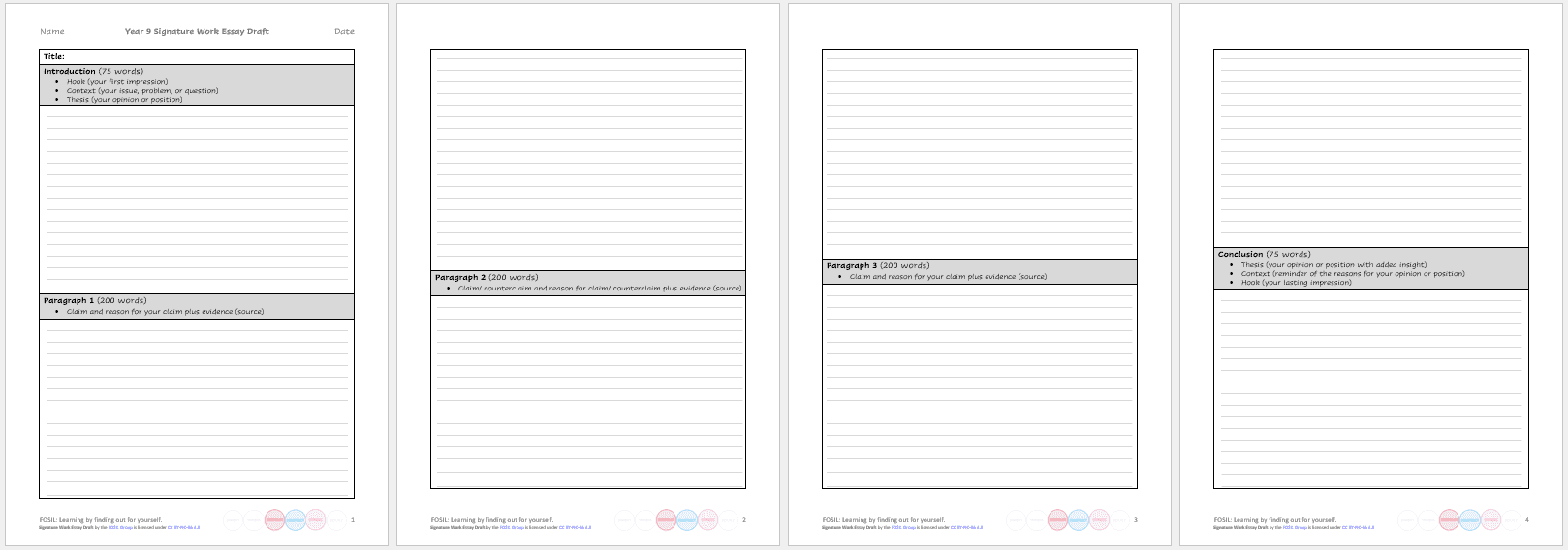
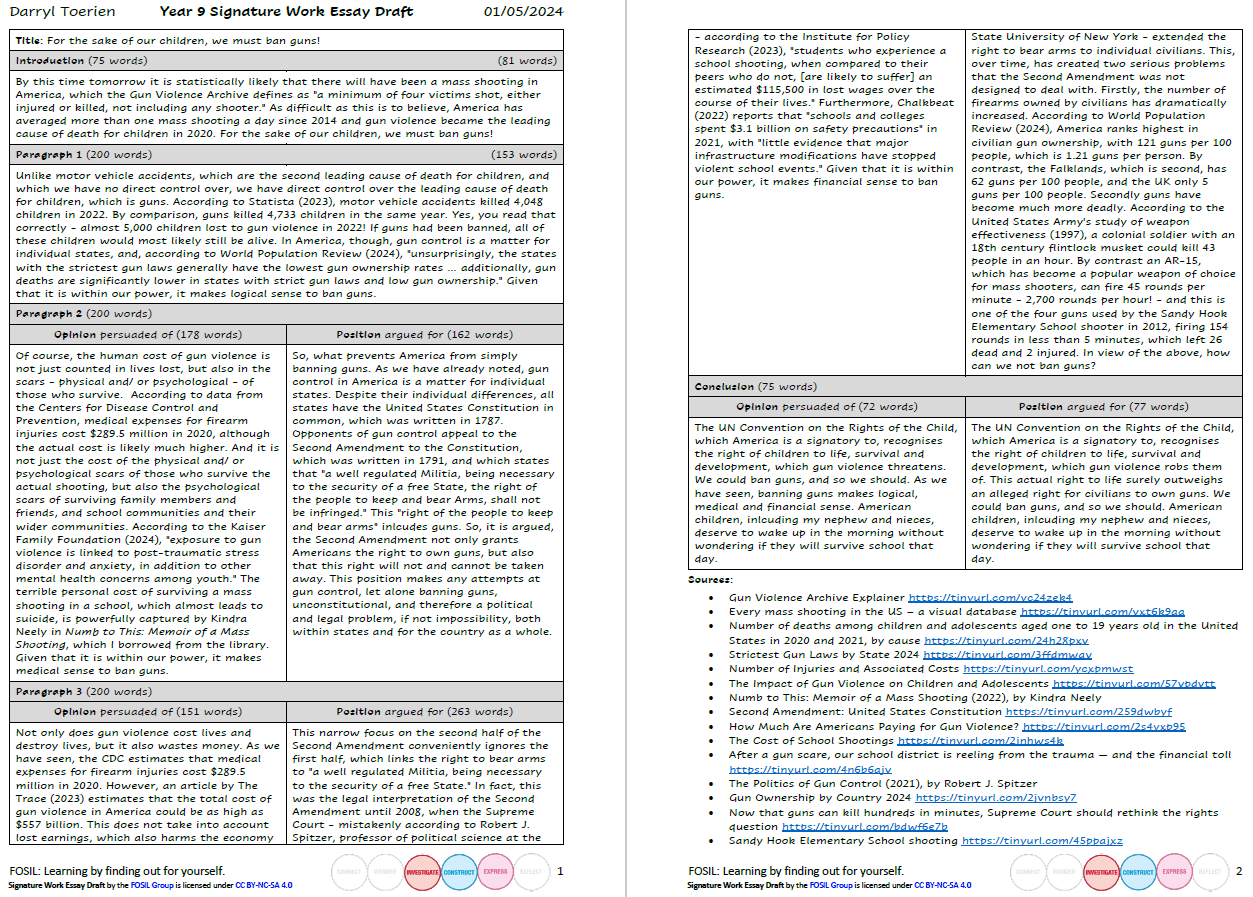
*Wells, G. (2001). The Case for Dialogic Inquiry. In G. Wells (Ed.), Action, Talk & Text: Learning and Teaching Through Inquiry (pp. 171-194). New York, NY: Teachers College Press.
3rd May 2024 at 3:23 pm #83298Students are drafting their essays and I am deeply impressed by the quality of their work (click on image to enlarge), especially considering that more broadly we are working to centre education in the learning process, rather than in the teaching process, encourage initiative and independence on the part of students, and bring students to grips with original thought as expressed in books and other media.
Edit: I will develop this further, but I should add that this is a sure way to develop academic integrity and to be sure of academic integrity. Furthermore, read what these students have written, or, better yet, discuss it with them, and you will be in no doubt about how much they have learnt for themselves, and how deeply they have learnt it.
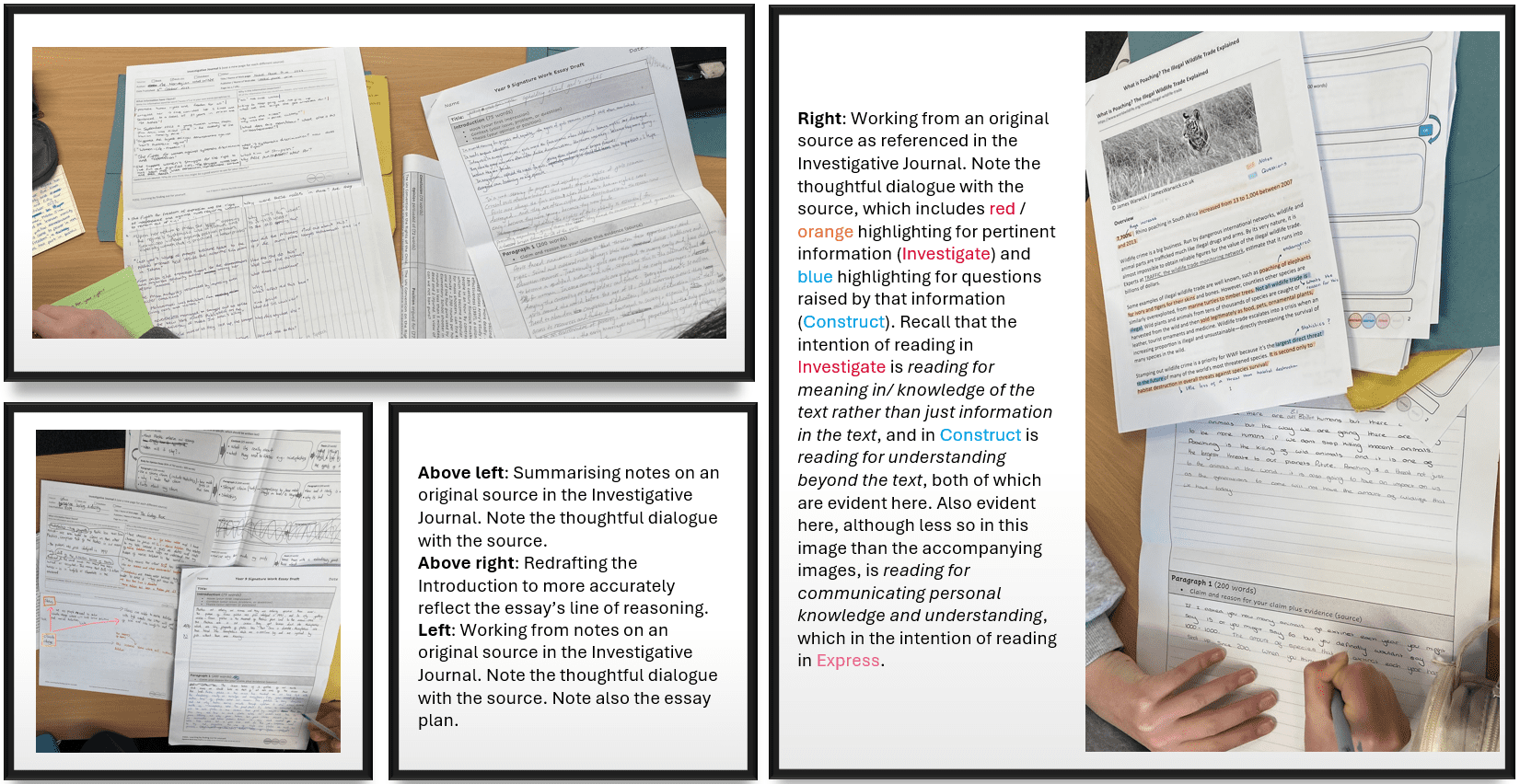 16th May 2024 at 11:32 am #83390
16th May 2024 at 11:32 am #83390Students have now finished drafting their essay and are working with their English teachers to develop their essay into a speech. I missed the first of these lessons last week due to the Year 2 (Grade 1) Signature Work Inquiry field trip to Herm Island, but will reflect on this aspect in due course.
In ICT this week, students produced their poster for our Year 9 Signature Work Inquiry Celebration on 20 June (click on image to enlarge).
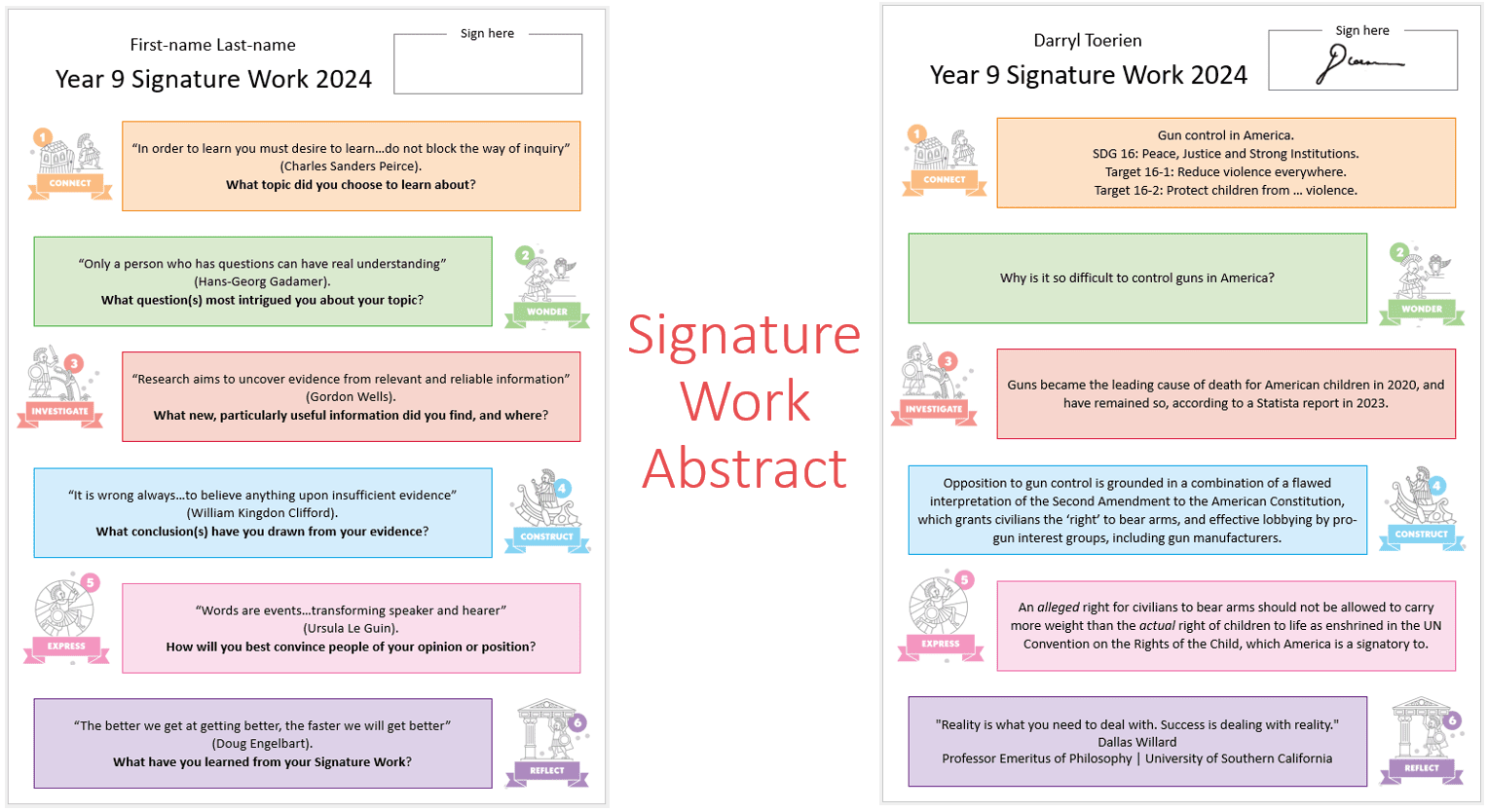
With the introduction of the essay into the Signature Work this year, it occurred to me that the poster, which I developed last year, also serves quite well as an introduction to the idea of an abstract. I will explore this more deliberately next year.
-
AuthorPosts
- You must be logged in to reply to this topic.


